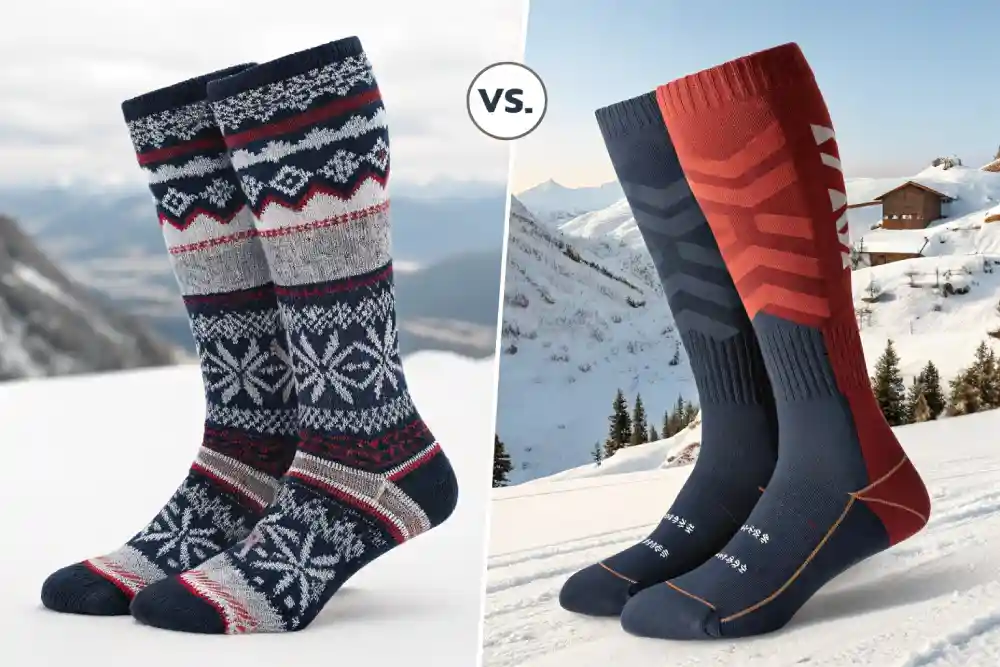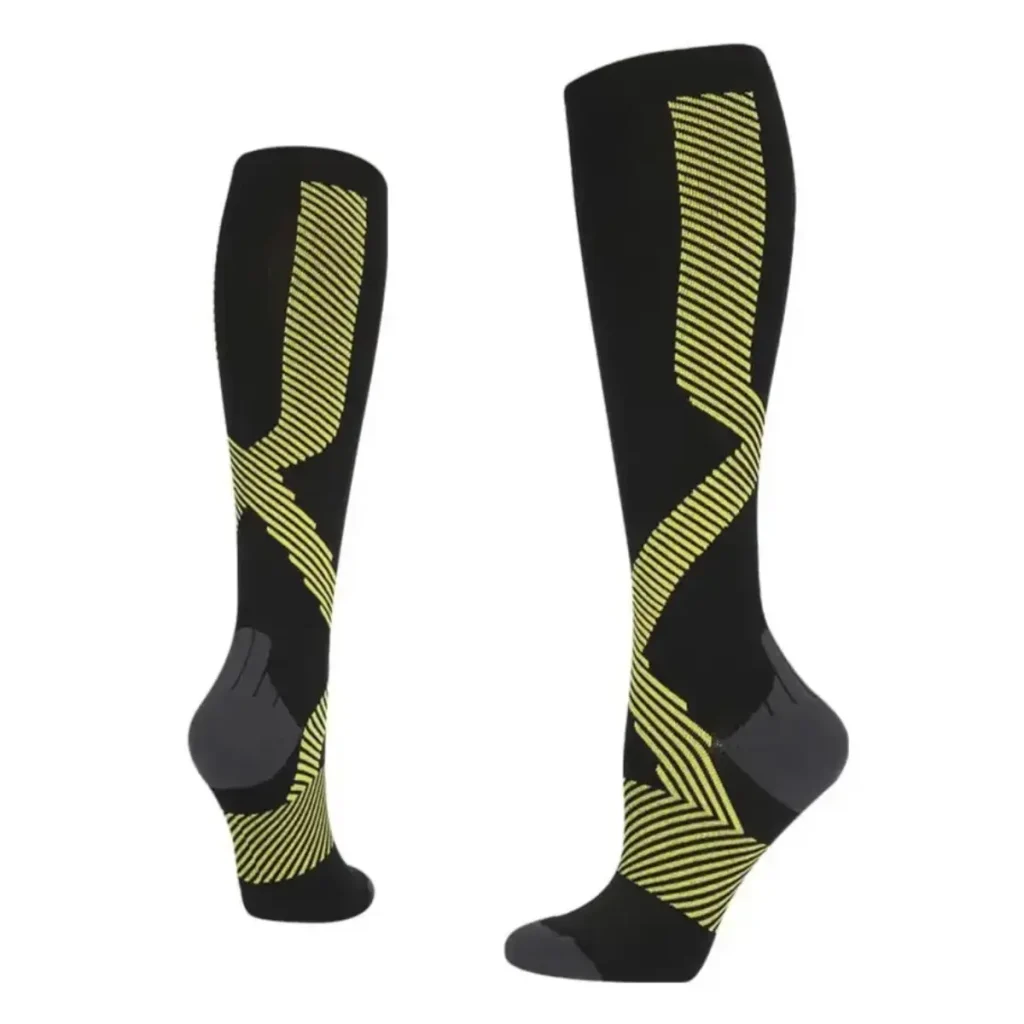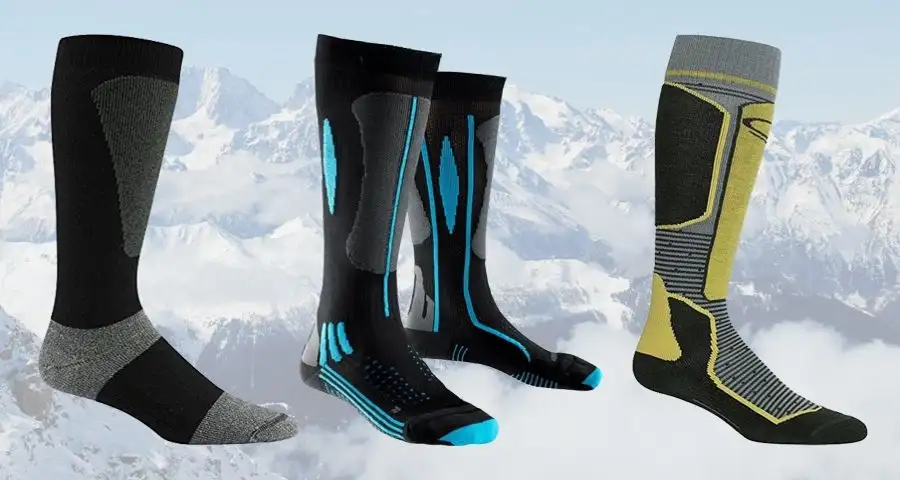Introduction
Choosing the right socks for skiing or sports can make a big difference in comfort and performance. Ski socks and compression socks might seem similar, but they serve different purposes. Ski socks are designed to keep your feet warm, cushion your legs, and prevent discomfort during long ski sessions. Compression socks, however, help improve blood flow, reduce swelling, and support recovery after exercise. For brands and retailers, understanding these differences is key to offering the right product for your customers.
A ski sock’s primary job is performance inside a ski boot, focusing on warmth, moisture-wicking, and strategic padding (especially on the shin). A compression sock’s job is purely physiological: to apply graduated pressure that enhances blood flow for muscle recovery or medical support, regardless of the activity.
In this article, we’ll explore how these socks differ and how you can choose the best option to meet your customers’ needs.

What Are Compression Socks? Key Features and Benefits
How Compression Socks Work: Gradient Pressure Explained
Compression socks use a unique design that applies pressure to the legs in a gradient manner. This means the pressure is strongest at the ankle and gradually decreases as it moves up the leg. The goal is to help your blood circulate more effectively, allowing oxygen and nutrients to reach your muscles while helping to remove waste products from the bloodstream. This can lead to reduced swelling and less muscle fatigue. For a more in-depth understanding of how gradient pressure works, you can consult this article on graduated compression.
The Health and Comfort Benefits of Compression Socks
Wearing compression socks can offer several health benefits, particularly for those who stand or move for long periods. By supporting proper circulation, these socks help reduce swelling in the feet and legs, making them a great option for athletes or anyone experiencing tired, aching legs. Many users also report feeling more comfortable and less fatigued after wearing them during physical activity or after prolonged standing.

Promotes Blood Circulation and Reduces Swelling
One of the main advantages of wearing compression socks is improved blood circulation. This can lead to reduced swelling, particularly in the lower legs and feet. By improving circulation, compression socks can help prevent conditions like varicose veins and reduce the risk of blood clots, making them a smart choice for people who are on their feet a lot or recovering from exercise.
A Medical Tool for Venous Return: Origins in Healthcare
Compression socks were originally developed for medical use, specifically to treat venous insufficiency and other circulation-related issues. By encouraging venous return, they help blood flow back to the heart more efficiently, preventing blood from pooling in the lower extremities. Today, these socks are commonly used not only for medical purposes but also for athletic performance and recovery.
What Are Ski Socks? Purpose and Essential Features
Ski Socks vs Regular Socks: Designed for Skiing Performance
Ski socks are specifically designed to meet the unique needs of skiers. Unlike regular socks, which are made for everyday wear, ski socks focus on providing comfort, warmth, and protection against the harsh conditions of skiing. They’re crafted with extra padding to cushion key areas such as the shins, heels, and arches, ensuring a better fit inside ski boots and reducing the risk of blisters and pressure points.

Key Features: Warmth, Moisture Wicking, and Cushioning
The primary job of ski socks is to keep your feet warm and dry. They are often made with materials that wick moisture away from your skin, helping to regulate temperature and prevent the cold, clammy feeling that can make skiing uncomfortable. The additional cushioning provides extra comfort and shock absorption, especially during long days on the slopes.
Merino Wool vs Synthetic Blends: Pros and Cons
Ski socks are typically made from either merino wool or synthetic blends. Merino wool is known for its excellent warmth and moisture-wicking properties, making it a great option for cold weather. It’s also naturally odor-resistant. On the other hand, synthetic blends are more durable, dry faster, and are often more affordable. Both materials have their advantages, so choosing between the two depends on your customers’ preferences and needs.
The Role of Ski Socks in Reducing Pressure Points
One of the key features of ski socks is their ability to reduce pressure points in the feet and legs. The design of these socks helps distribute pressure more evenly across the foot, preventing discomfort that can be caused by the tightness of ski boots. This ensures that skiers can stay comfortable longer, avoiding pain that might otherwise ruin their experience on the slopes.
Ski Socks Do Not Provide Compression: Focusing on Comfort
Unlike compression socks, ski socks are not designed to provide pressure or support to the legs. Instead, they focus on comfort and cushioning to prevent blisters and enhance warmth during skiing. While compression socks help with circulation and muscle support, ski socks prioritise the fit and comfort needed for a smooth and enjoyable experience on the slopes.
How Compression Socks and Ski Socks Differ
Compression vs. Padding: Functionality in Action
Compression socks and ski socks have distinct roles. Compression socks provide a targeted pressure to stimulate circulation and reduce swelling, aiding in recovery and muscle support. On the other hand, ski socks focus on enhancing comfort by offering extra padding that cushions key areas like the feet and shins. While compression socks are performance-driven, aiming to boost circulation, ski socks are designed for comfort and protection during skiing.
Compression Promotes Circulation; Ski Socks Focus on Warmth
Compression socks help improve circulation by applying graduated pressure, which helps reduce swelling and supports muscle recovery. Ski socks, however, are crafted to keep feet warm, dry, and comfortable, which is essential when skiing in cold temperatures. The primary goal of ski socks is to ensure warmth and comfort throughout the day, whereas compression socks work to improve circulation and reduce muscle fatigue.
Fit and Length: Comparing the Key Differences
Compression socks are typically designed to cover the ankle to the calf, providing a snug fit to promote circulation. Ski socks are generally longer, extending up to the knee, to protect the lower leg and provide cushioning inside ski boots. While compression socks focus on snugness and targeted support, ski socks are designed for longer wear and comfort, ensuring that there is no discomfort caused by boot pressure or rubbing.
Ski Socks: Longer to Protect the Shin and Provide Cushioning
A notable feature of ski socks is their length. These socks often reach up to or just below the knee, offering full coverage and protecting the shin from the pressure of ski boots. The extended length also provides extra cushioning and padding, reducing discomfort during long hours on the slopes. This ensures that skiers remain comfortable and can focus on their performance without worrying about sore feet.

Compression Socks: Focused on Targeted Leg Compression from Ankle to Calf
Compression socks are designed to provide specific compression, starting at the ankle and gradually decreasing as it moves up the calf. This helps to encourage blood flow and reduce swelling, making them ideal for recovery after physical activity. Unlike ski socks, which prioritize cushioning and warmth, compression socks are focused on enhancing circulation, supporting muscle function, and reducing fatigue, especially during intense physical activities. For more on the medical applications and types of compression socks, the American Academy of Orthopaedic Surgeons offers relevant information.
Ski Socks for Skiing: Are Compression Socks the Better Choice?
Can Compression Socks Be Used as Ski Socks?
While compression socks and ski socks are both designed for leg support, they serve different functions. Compression socks can be used during skiing, but they won’t provide the same level of warmth, padding, or protection as ski socks. Compression socks are primarily beneficial for improving circulation and supporting recovery, but ski socks are specifically designed to keep your feet warm and cushion the pressure points created by ski boots.
The Pros and Cons of Using Compression Socks for Skiing
Compression socks have benefits like improving blood flow and reducing swelling, which can support recovery after skiing. They also help prevent leg fatigue during physical activity. However, they don’t offer the insulation or comfort needed for long days on the slopes, which ski socks provide. Ski socks are made to wick moisture, keep feet warm, and cushion the shins and feet, which are crucial in cold conditions. Compression socks may not offer enough warmth or protection in harsh skiing environments.
When to Choose Compression Socks Over Regular Ski Socks
Compression socks may be a better choice for skiers who want to enhance circulation and recovery post-skiing. They’re ideal for reducing swelling and fatigue after intense activity. For brands targeting skiers who need a recovery solution or want to improve performance during skiing, compression socks are a great option. However, for customers primarily concerned with comfort, warmth, and protection during skiing, ski socks are still the better option.
Ski Boots and Compression Socks: Limited Impact on Arterial Flow
Although compression socks aid in venous return, they have a limited effect on arterial blood flow, particularly when worn inside tight ski boots. The pressure from the boots combined with the compression may restrict blood flow to the toes, especially in those with poor circulation. In colder conditions, this could make the feet feel colder. Ski socks, which provide more insulation and padding, are a better choice for warmth and comfort in ski boots, especially for those with circulation issues.
How to Choose Ski Socks: Retailer Guidelines for Quality
Material Breakdown: Merino Wool vs. Synthetic Blends (Nylon, Spandex)
The material of ski socks plays a significant role in their performance. Merino wool is known for its superior warmth retention and moisture-wicking ability, making it a top choice for cold weather. It’s naturally breathable and resistant to odors, which enhances comfort. However, it tends to be pricier. On the other hand, synthetic materials like nylon and spandex offer durability, quick-drying properties, and greater elasticity. A blend of these materials is often preferred, as it provides both warmth and resilience, making them ideal for long-lasting wear and performance on the slopes.
Fit Rules: Preventing Slippage, Avoiding Toe Numbness
A well-fitting ski sock ensures comfort throughout the day, minimizing the risk of slippage and toe numbness. Ski socks should fit snugly without being tight, providing a secure hold without restricting blood flow. The right fit will keep the socks in place, preventing them from bunching or sliding down inside the ski boot, which could lead to discomfort or chafing. At the same time, ensure that the socks aren’t too tight to avoid constricting circulation, particularly around the toes, which can cause numbness.
Thickness and Compression Levels
When selecting ski socks, the thickness and level of compression should align with the skier’s boot stiffness and skill level. Thicker socks are beneficial for beginners or those who prefer extra cushioning and warmth. For more advanced skiers or those with stiffer boots, thinner socks may be more suitable as they provide a better fit and greater sensitivity. Compression socks can also be considered for mild pressure (15-20mmHg) to enhance circulation and muscle support, which is especially helpful for athletes who want to reduce fatigue and improve recovery.
Seamless Design: Why It’s a Selling Point for Long-Day Comfort
Seamless ski socks are a valuable selling feature for skiers who spend long days on the slopes. A seamless construction eliminates the risk of pressure points and irritation, which can lead to blisters or discomfort. The smooth, continuous fabric design provides a comfortable fit that moves with the body without causing friction. This feature is particularly appealing to customers who seek durability and comfort for extended ski sessions, as it minimizes the chances of chafing and enhances overall satisfaction.

How to Choose the Right Compression Sock for Different Activities
Selecting Compression Socks Based on Activity Type
Choosing the right compression sock depends largely on the activity it will support. For high-intensity activities like running or hiking, socks with firmer compression (20-30mmHg) are ideal, as they help reduce muscle fatigue and enhance performance. For activities like skiing, a moderate compression level (15-20mmHg) can help improve circulation without restricting movement. Daily use or light activities can benefit from lower compression levels (8-15mmHg), which offer gentle support and comfort.
Skiing, Running, and Daily Use: Finding the Right Compression Level
The right compression level varies by activity. For skiing and other intense sports, moderate compression helps reduce swelling and provides muscle support. Runners, especially those engaging in long-distance activities, often prefer stronger compression for enhanced circulation and reduced fatigue. For everyday wear, light compression helps alleviate mild swelling or discomfort from standing or sitting for extended periods without being restrictive.
Why Custom Compression Socks Are Crucial for Brands and Retailers
Custom compression socks are essential for offering personalised solutions to meet specific customer needs. With customizable features like pressure gradients, moisture-wicking fabrics, and branded designs, your business can cater to athletes, travellers, or wellness-focused buyers—ensuring the perfect match for their needs. This level of tailoring not only drives satisfaction but also fosters loyalty, as clients return for gear that truly works. Learn more info about custom compression socks.
Customizable Options: Size, Fit, and Compression Levels
One of the key benefits of custom compression socks is the ability to adjust size, fit, and compression levels. Offering a variety of sizes ensures that every customer gets the perfect fit, which is crucial for effective compression. Additionally, customizable compression levels cater to different activities, whether it’s a lighter pressure for daily wear or higher pressure for more intense activities like running or skiing. This flexibility helps retailers meet a wider range of customer needs.
Matching Customer Needs with Proper Compression Support
To ensure that your compression socks are successful, it’s important to match the right level of support with your customers’ specific needs. Whether they are athletes, travellers, or those seeking relief from swelling, offering tailored solutions ensures they receive the best benefits. By understanding customer preferences and activities, you can provide products that enhance their comfort, improve their performance, and ultimately drive customer satisfaction and retention.
Conclusion: Ski Socks vs Compression Socks – Which Should You Choose for Your Brand?
Ski socks and compression socks serve different purposes. Ski socks are made for warmth, comfort, and protection from ski boots, while compression socks help improve circulation and reduce swelling. Both have unique benefits, and understanding these differences will help you choose the right product for your customers.
Partnering with a reliable manufacturer like us, Max Hosiery, for custom compression socks lets you provide socks that meet your customers’ specific needs. Custom options like size and compression levels ensure a better fit and improve customer satisfaction. Working with an experienced manufacturer also means quality and consistency, helping your brand stand out and build trust with customers.
FAQs
What is the main difference between ski socks and compression socks?
A ski sock’s primary job is warmth, moisture management, and strategic padding for comfort inside a ski boot. A compression sock’s main purpose is to improve blood circulation to reduce muscle fatigue and enhance recovery. While they can overlap, their core functions are distinct.
Are ski socks just another name for thermal socks?
No. While ski socks are thermal, their design is far more advanced. They are engineered to be highly breathable to prevent sweat from making your feet cold and damp. They also feature specific padding on the shin and heel to protect against the unique pressures of a ski boot.
What are the specific benefits of wearing compression socks for skiing?
Compression improves blood flow, which helps keep your legs feeling fresh and reduces muscle fatigue on long ski days. This enhanced circulation also delivers more warmth to your feet, fighting that numb, frozen-toe feeling and allowing you to ski more comfortably for longer.
Can I get the benefits of both? Do compression ski socks exist?
Yes, absolutely! You don’t have to choose. Many brands offer specialized compression ski socks that combine graduated compression for muscle support with the thermal, moisture-wicking, and padded features of a high-performance ski sock. It’s the best of both worlds in a single sock.
How do I decide which type of sock is right for my ski day?
Choose a standard, high-quality ski sock for excellent all-around warmth and padded protection. Opt for a compression ski sock if you are prone to leg fatigue, muscle soreness, or suffer from chronically cold feet. The boost in circulation can make a significant difference in your endurance and comfort.
